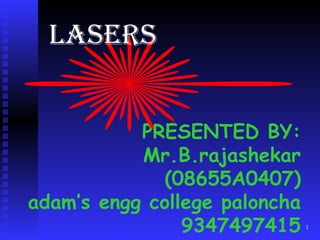
Laser ppt
- 1. PRESENTED BY: Mr.B.rajashekar (08655A0407) adam’s engg college paloncha 9347497415 LASERS
- 2. Fundamentals of Laser Operation
- 6. Laser Components Gas lasers consist of a gas filled tube placed in the laser cavity. A voltage (the external pump source) is applied to the tube to excite the atoms in the gas to a population inversion. The light emitted from this type of laser is normally continuous wave (CW).
- 8. Lasing Action Diagram Energy Introduction Ground State Excited State Metastable State Spontaneous Energy Emission Stimulated Emission of Radiation
- 9. Laser Output watt (W) - Unit of power or radiant flux (1 watt = 1 joule per second). Joule (J) - A unit of energy Energy (Q) The capacity for doing work. Energy content is commonly used to characterize the output from pulsed lasers and is generally expressed in Joules (J). Irradiance (E) - Power per unit area, expressed in watts per square centimeter. Time Continuous Output (CW) Pulsed Output (P) Energy (Watts) Time Energy (Joules)
- 10. Laser Hazards
- 14. Control Measures and Personal Protective Equipment
- 16. Common Laser Signs and Labels
- 17. CONCLUSION: Laser communication in space has long been a goal for NASA because it would enable data transmission rates that are 10 to 1,000 times higher than traditional radio waves. While lasers and radio transmissions both travel at light-speed, lasers can pack more data. It's similar to moving from a dial-up Internet connection to broadband. Astronomers could use lasers like very accurate rulers to measure the movement of planets with unprecedented precision. With microwaves, we're limited to numbers like a meter or two in distance, whereas [lasers have] a potential for getting down into well beyond the centimeter range.
- 18. THANK YOU
